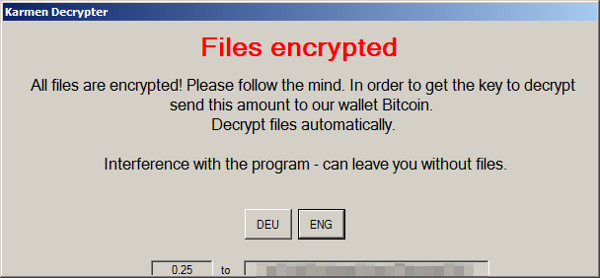RANSOM_HIDDENTEARKARMEN.A
Windows


Threat Type: ransomware
Destructiveness: No
Encrypted:
In the wild: Yes
OVERVIEW
Dropped by other malware, Downloaded from the Internet
This ransomware arrives on a system as a file dropped by other malware or as a file downloaded unknowingly by users when visiting malicious sites.
It executes the downloaded files. As a result, malicious routines of the downloaded files are exhibited on the affected system.
It connects to certain websites to send and receive information.
TECHNICAL DETAILS
12,800 bytes
EXE
No
15 Mar 2017
Connects to URLs/IPs, Encrypts files
Arrival Details
This ransomware arrives on a system as a file dropped by other malware or as a file downloaded unknowingly by users when visiting malicious sites.
Autostart Technique
This ransomware adds the following registry entries to enable its automatic execution at every system startup:
HKEY_CURRENT_USER\Software\Microsoft\
Windows\CurrentVersion\Run
DecryptFiles = C:\Users\{username}\AppData\Local\Temp\decrypt.exe
Dropping Routine
This ransomware drops the following files:
- C:\Users\{username}\AppData\Local\Temp\id.txt - 15 random characters
- C:\Users\{username}\AppData\Local\Temp\adr.txt - bitcoin address
- C:\Users\{username}\AppData\Local\Temp\lnk.txt - server
- C:\Users\{username}\AppData\Local\Temp\btc.txt - bitcoins to pay
- C:\Users\{username}\AppData\Local\Temp\del.bat - terminates and deletes decrypt.exe, and deletes the text files
Download Routine
This ransomware accesses the following websites to download files:
- http://{BLOCKED}.{BLOCKED}.123.78/decrypt.exe
It saves the files it downloads using the following names:
- C:\Users\{username}\AppData\Local\Temp\decrypt.exe - ransom note and decrypt program
It then executes the downloaded files. As a result, malicious routines of the downloaded files are exhibited on the affected system.
Other Details
This ransomware connects to the following website to send and receive information:
- http://{BLOCKED}.{BLOCKED}.123.78/
It encrypts files with the following extensions:
- .sql
- .csv
- .zip
- .mdbackup
- .syncdb
- .css
- .js
- .txt
- .doc
- .docx
- .exl
- .kdbx
- .kdb
It renames encrypted files using the following names:
- {original filename and extension}.grt
NOTES:
Decrypt.exe shows the following message:

SOLUTION
9.850
13.280.00
16 Mar 2017
13.281.00
17 Mar 2017
Step 1
Before doing any scans, Windows XP, Windows Vista, and Windows 7 users must disable System Restore to allow full scanning of their computers.
Step 2
Note that not all files, folders, and registry keys and entries are installed on your computer during this malware's/spyware's/grayware's execution. This may be due to incomplete installation or other operating system conditions. If you do not find the same files/folders/registry information, please proceed to the next step.
Step 3
Restart in Safe Mode
Step 4
Delete this registry value
Important: Editing the Windows Registry incorrectly can lead to irreversible system malfunction. Please do this step only if you know how or you can ask assistance from your system administrator. Else, check this Microsoft article first before modifying your computer's registry.
- In HKEY_CURRENT_USER\Software\Microsoft\Windows\CurrentVersion\Run
- DecryptFiles = C:\Users\{username}\AppData\Local\Temp\decrypt.exe
- DecryptFiles = C:\Users\{username}\AppData\Local\Temp\decrypt.exe
Step 5
Search and delete this file
- C:\Users\{username}\AppData\Local\Temp\id.txt
- C:\Users\{username}\AppData\Local\Temp\adr.txt
- C:\Users\{username}\AppData\Local\Temp\lnk.txt
- C:\Users\{username}\AppData\Local\Temp\btc.txt
- C:\Users\{username}\AppData\Local\Temp\del.bat
- C:\Users\{username}\AppData\Local\Temp\decrypt.exe
Step 6
Restart in normal mode and scan your computer with your Trend Micro product for files detected as RANSOM_HIDDENTEARKARMEN.A. If the detected files have already been cleaned, deleted, or quarantined by your Trend Micro product, no further step is required. You may opt to simply delete the quarantined files. Please check this Knowledge Base page for more information.
Step 7
Restore encrypted files from backup.
Did this description help? Tell us how we did.

